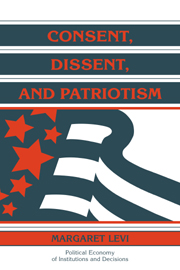Book contents
- Frontmatter
- Contents
- Series editors' preface
- Acknowledgments
- 1 HISTORY AS POLITICS
- 2 THE CONTINGENCIES OF CONSENT
- 3 GONE FOR A SOLDIER
- 4 THE PRICE OF CITIZENSHIP
- 5 THE INSTITUTION OF CONSCRIPTION
- 6 GIVING AND REFUSING CONSENT: CITIZEN RESPONSE IN THE CANADIAN CONSCRIPTION CRISES
- 7 A WEAPON AGAINST WAR: CONSCIENTIOUS OBJECTION IN THE UNITED STATES, AUSTRALIA, AND FRANCE
- 8 THE DEMOCRATIZATION OF COMPLIANCE
- Bibliography
- Index
- Titles in the series
5 - THE INSTITUTION OF CONSCRIPTION
Published online by Cambridge University Press: 10 December 2009
- Frontmatter
- Contents
- Series editors' preface
- Acknowledgments
- 1 HISTORY AS POLITICS
- 2 THE CONTINGENCIES OF CONSENT
- 3 GONE FOR A SOLDIER
- 4 THE PRICE OF CITIZENSHIP
- 5 THE INSTITUTION OF CONSCRIPTION
- 6 GIVING AND REFUSING CONSENT: CITIZEN RESPONSE IN THE CANADIAN CONSCRIPTION CRISES
- 7 A WEAPON AGAINST WAR: CONSCIENTIOUS OBJECTION IN THE UNITED STATES, AUSTRALIA, AND FRANCE
- 8 THE DEMOCRATIZATION OF COMPLIANCE
- Bibliography
- Index
- Titles in the series
Summary
Johnnie get your gun, get your gun, get your gun,
Take it on the run, on the run, on the run,
Hear them calling you and me,
Ev'ry son of liberty.
George M. Cohan, “Over There”Why is your face so white, Mother?
Why do you choke for breath?
“Oh I have dreamt in the night, my son,
That I doomed a man to death.
“The Blood Vote,” anticonscription propaganda, Australia, 1916Hurry right away, no delay, go today,
Make your daddy glad to have had such a lad,
Tell your sweetheart not to pine,
To be proud her boy's in line.
“They gave me the ballot paper,
The grim death warrant of doom
And I smugly sentenced the man to death
In that dreadful little room.”
The chronicle of mass conscription in modern democracies is the story of the changing relationship between the state and its citizens, and the Great War is one of the major turning points, especially in the Anglo-Saxon democracies. The institution of conscription significantly extends the obligations of male citizens and the reach of the state. Its history offers insight into both the institutional arrangements that promote or undermine the consent of the governed and the changing bases for that consent.
The high degree of citizen support necessary for conscription hinges on the perception of an acceptable policy bargain whose terms government actors are likely to uphold. The minimal terms of the democratic conscription bargain are that government will conscript according to some legislated and relatively equitable formula.
- Type
- Chapter
- Information
- Consent, Dissent, and Patriotism , pp. 107 - 133Publisher: Cambridge University PressPrint publication year: 1997



